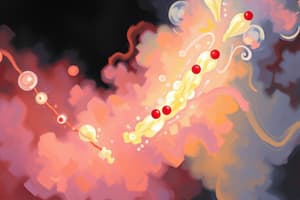Podcast
Questions and Answers
What is a gas?
What is a gas?
A state of matter that seems to be hard to understand because their physical characteristics are not readily seen.
A gas has a definite shape and volume.
A gas has a definite shape and volume.
False (B)
Gases expand when cooled.
Gases expand when cooled.
False (B)
How is the volume of a gas determined?
How is the volume of a gas determined?
Name common units of volume used in gas measurements.
Name common units of volume used in gas measurements.
What is pressure of a gas?
What is pressure of a gas?
What is the Earth's atmospheric pressure?
What is the Earth's atmospheric pressure?
Name common units of pressure and their equivalent values.
Name common units of pressure and their equivalent values.
How the temperature of gas determined?
How the temperature of gas determined?
Which temperature unit is used in computations involving temperature of gas?
Which temperature unit is used in computations involving temperature of gas?
Provide formulas for converting temperature units.
Provide formulas for converting temperature units.
What is the standard condition for a gas?
What is the standard condition for a gas?
What is Boyle's Law?
What is Boyle's Law?
Flashcards
Gas
Gas
A state of matter with no definite shape or volume, occupying all available space.
Volume (of a gas)
Volume (of a gas)
The space occupied by a gas, equivalent to the container's volume, measured in liters (L) or cubic meters (m3).
Pressure (of a gas)
Pressure (of a gas)
The force exerted by gas molecules on the container walls, measured in Pascals (Pa) or atmospheres (atm).
Temperature (of a gas)
Temperature (of a gas)
Signup and view all the flashcards
Standard Temperature and Pressure (STP)
Standard Temperature and Pressure (STP)
Signup and view all the flashcards
Boyle's Law
Boyle's Law
Signup and view all the flashcards
Boyle's Law equation
Boyle's Law equation
Signup and view all the flashcards
Study Notes
- Gas is a state of matter that is seemingly difficult to comprehend because its physical characteristics are not readily seen.
- Gas behavior is predictable when temperature and pressure are varied.
General Properties of Gas
- Gas has no definite shape or volume.
- Gas volume is based on the volume of its container.
- Gases occupy all spaces available in their container.
- Gases are compressible when pressure is applied.
- Gases also exert pressure.
- Gases expand when heated, and contract when cooled.
- The intermolecular force of attraction between gas particles is negligible.
- Gas particles diffuse easily.
Measurable Properties of Gas
- Volume is equal to the volume of its container, as it occupies all available space.
- Common units of volume used in gas measurements:
- Liter (L)
- Milliliter (mL)
- Cubic meter (m³)
- Cubic centimeter (cm³)
- Pressure is the force exerted by gas molecules on the walls of its container, divided by the surface area of the container.
- Earth's atmosphere exerts a pressure of 1.013 x 10⁵ N/m² or 1 atm.
- Atmospheric pressure decreases as altitude increases.
- Common units of pressure and their equivalent:
- 1 atm = 1.013 x 10⁵ N/m² = 1.013 x 10⁵ Pa
- 1 atm = 760 torr = 760 mmHg
- 1 atm = 14.696 psi
- Temperature is the average kinetic energy of the particles of gas.
- Usually determined using a thermometer.
- Expressed in degree Celsius (°C), degree Fahrenheit (°F), and Kelvin (K).
- Only Kelvin is used in computations involving temperature of gas.
- Useful formulas for converting units of temperature:
- °C = (°F - 32) / 1.8
- °F = 1.8°C + 32
- K = °C + 273
Standard Conditions of a Gas
- Also known as STP, or Standard Temperature and Pressure.
- Standard temperature is the melting point of ice, at 0°C or 273K.
- Standard pressure is the average atmospheric pressure at sea level, equal to 1 atm.
- One mole of gas occupies a volume of 22.4 L.
- The inverse relationship exists in an enclosed container between the volume and the pressure of a gas.
- Pushing the plunger increases pressure and decreases gas volume inside the balloon.
- Pulling the plunger decreases pressure, increasing gas volume.
Boyle's Law
- Formulated by Robert Boyle.
- States that “The volume of a fixed amount of gas is inversely proportional to its pressure at constant temperature.”
- If pressure decreases, volume increases, and vice versa.
Basic Equation
- P₁V₁ = P₂V₂
- P₁ = initial pressure
- V₁ = initial volume
- P₂ = final pressure
- V₂ = final volume
- Formulas:
- P₁ = (P₂V₂) / V₁
- P₂ = (P₁V₁) / V₂
- V₁ = (P₂V₂) / P₁
- V₂ = (P₁V₁) / P₂
Studying That Suits You
Use AI to generate personalized quizzes and flashcards to suit your learning preferences.




